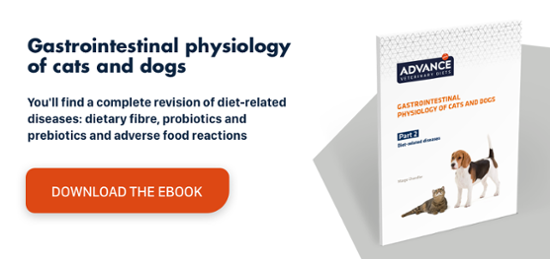Vomiting in dogs and gastrointestinal motility disorders
Vomiting in dogs is associated with a wide group of diseases. As explained in the manual on Small Animal Medical Differential Diagnosis1, vomiting in dogs can be classified according to eight different underlying causes: gastric disease, small intestine disease, large intestine disease, diet, medications, an extra-gastrointestinal tract disease, poisoning or neurological diseases. Most cases are due to the first two causes, that is, gastrointestinal problems, and 89% of cases signs resolve within 2 days according to an investigation published in The Journal of Small Animal Practice2.
Chronic vomiting, however, may be due to a primary gastrointestinal motility disorder, a situation with a better prognosis if the primary cause is improved or resolved.
Gastrointestinal motility disorders: causes
The digestive tract is in a permanent state of contractility, which stimulates the digestion, absorption and secretion of substances. The muscles, epithelium, local nerves in the enteric nervous system, the autonomic nervous system and circulating hormones are all involved in these movements.
When the brain’s vomiting centre is stimulated, it triggers a series of visceral events, such as the sequential inhibition of proximal gastrointestinal motility. This retrograde contraction in the small intestine, combined with antral relaxation, means that gastric contents are transferred to the oesophagus. The result is retching and Vomiting.
The clinical signs derived from poor gastric emptying may be due to impaired motility. The main causes of gastrointestinal motility disorders are:
- Gastric retention/delayed emptying
- Idiopathic megacolon
Similarly, secondary gastrointestinal disorders that affect motility in dogs may be due to mechanical or functional causes. The most common mechanical cause is a gastrointestinal obstruction , such as intussusceptions, stenosis, tumours and foreign bodies, among others.
Functional causes include severe inflammation of the intestinal wall, oesophagitis, reflux oesophagitis. Obstructions can also be secondary to endocrine disorders, such as hyperadrenocorticism and Hypothyroidism, metabolic diseases, neuromuscular disorders and paraneoplastic syndrome.
Gastrointestinal motility disorders in dogs: diagnosis
- Blood tests should be used to rule out metabolic, electrolyte and acid–base problems as a result of chronic vomiting.
- Abdominal X-rays to determine if there is a pattern of obstructive gas, ileus or any opaque foreign bodies.
- Abdominal ultrasound to identify any foreign bodies, tumours or thickening of the wall of the small intestine.
Treatment of vomiting caused by gastrointestinal motility disorders
It is important to determine if the area of abnormal gastrointestinal motility is located proximally or distally when selecting the right prokinetic agent. A study presented at the 2nd Conference of the South California VMA3 indicated that vomiting due to gastrointestinal motility disorders should be treated with prokinetic agents, as nonspecific motility stimulators with cholinergic agents are not effective.
Although metoclopramide, for instance, has a very potent central antiemetic effect, it has a very limited peripheral gastrokinetic effect and should not be considered a first-line medicine. Nor should it be used in dogs with a suspected gastrointestinal obstruction, as it could lead to a perforation.
Erythromycin is a good alternative for accelerating gastric emptying, because it stimulates stomach contractions which helps void solids, as reported in a study conducted at the University of FloridaUniversity of Florida4. In this case, patients should be administered a lower dose that that used for antibacterial purposes, as higher doses may induce vomiting. Ideally, it should be given 30 minutes before meals.
Cisapride, another drug with a prokinetic effect, acts at the mesenteric plexus, promoting acetylcholine release, which increases or totally restores gastrointestinal motility. Cisapride is currently the medicine of choice for delaying gastric emptying. Other therapeutic options include the combined use of erythromycin with ranitidine or nizatidine, a combination which, in addition to decreasing gastric acidity, may also have a prokinetic effect in the small intestine and colon.


